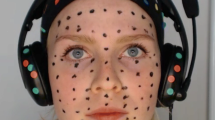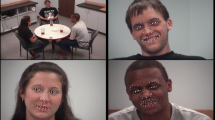Abstract
A procedure has been developed for measuring visibly different facial movements. The Facial Action Code was derived from an analysis of the anatomical basis of facial movement. The method can be used to describe any facial movement (observed in photographs, motion picture film or videotape) in terms of anatomically based action units. The development of the method is explained, contrasting it to other methods of measuring facial behavior. An example of how facial behavior is measured is provided, and ideas about research applications are discussed.
Similar content being viewed by others
References
Birdwhistell, R. L.Kinesics and Context. Philadelphia: University of Pennsylvania Press, 1970.
Blurton-Jones, N. G. Criteria for use in describing facial expressions in children.Human Biology, 1971,41, 365–413.
Duchenne, B.Mecanisme de la physionomie humaine ou analyse electrophysiologique de l'expression des passions. Paris: Bailliere, 1862.
Ekman, P., & Friesen, W. V.Manual for the facial action code. Palo Alto: Consulting Psychologists Press, in press.
Ekman, P., Friesen, W. V., & Tomkins, S. S. Facial affect scoring technique (FAST): A first validity study.Semiotica, 1971,3(1), 37–58.
Ekman, P., Friesen, W. V., & Ellsworth, P.Emotion in the human face: Guidelines for research and a review of findings. New York: Pergamon Press, 1972.
Ermiane, R.Le Visage et le caractère. Paris: Sabri, 1963.
Ermiane, R., & Gergerian, E.Atlas of Facial Expressions. Album des expressions du visage. In press.
Frois-Wittmann, J. The judgment of facial expression.Journal of Experimental Psychology, 1930,13, 113–151.
Fulcher, J. S. “Voluntary” facial expression in blind and seeing children.Archives of Psychology, 1942,38, 5–49.
Grant, E. C. Human facial expression.Man, 1969,4, 525–536.
Hjortsjö, C. H.Man's face and mimic language. Lund: Student-litteratur, 1970.
Huber, E.Evolution of facial musculature and facial expression. Baltimore: Johns Hopkins, 1931.
Landis, C. Studies of emotional reactions: II. General behavior and facial expression.Journal of Comparative Psychology, 1924,4, 447–509.
McGrew, W. C.An ethological study of children's behavior. New York: Academic Press, 1972.
Schwartz, G. Facial muscle patterning to affective imagery in depressed and nondepressed subjects.Science, in press.
Seaford, H. W., Jr. Maximizing replicability in describing facial behavior. American Anthropological Association Convention, Nov. 1976.
Thompson, J. Development of facial expression of emotion in blind and seeing children.Archives of Psychology, 1941,37, 5–47.
Reference Notes
Young, G., & Decarie, T. G. An ethology-based catalogue of facial/vocal behaviors in infancy. Educational Testing Service, Princeton, N.J., 1974.
Schwartz, personal communication, 1976.
Hager, J., Ekman, P., & Friesen, W. V. A comparison of facial measurement procedures. In P. Ekman & W. V. Friesen (Eds.),An atlas of facial action. Book in preparation.
Ekman, P. Facial signs. In T. Sebeok (Ed.),New approaches in semotics. Book in preparation.
Washburn, S. L. Personal communication, October, 1975.
Ekman, P., & Friesen, W. V. (Eds.).An atlas of facial action. Book in preparation.
Lidell, S. K. Restrictive relative clauses in American sign language. In E. Klima & U. Bellugi (Eds.),The signs of language. Cambridge: Harvard University Press, in press.
Johnson, H. J. Facial changes in response to treatment of children with Lesch-Nyhan syndrome. In P. Ekman & W. V. Friesen (Eds.),An atlas of facial action. Book in preparation.
Author information
Authors and Affiliations
Additional information
The research reported here was supported by a grant from NIMH, MH 167845. The authors are grateful to Wade Seaford, Dickinson College, for encouraging us to build our measurement system on the basis of specific muscular action. He convinced us that it would allow more precision, and that learning the anatomy would not be an overwhelming obstacle. Neither he nor we realized, however, how detailed and elaborate this undertaking would be. Seaford (1976) recently advanced some of the arguments we have made here about the value of an anatomically based measurement system. We are grateful also to those who first learned FAC and gave us many helpful suggestions as to how to improve the manual. We thank Linda Camras, Joe Hager, Harriet Oster, and Maureen O'Sullivan also for their comments on this report.
Rights and permissions
About this article
Cite this article
Ekman, P., Friesen, W.V. Measuring facial movement. J Nonverbal Behav 1, 56–75 (1976). https://doi.org/10.1007/BF01115465
Issue Date:
DOI: https://doi.org/10.1007/BF01115465




